

Jade Warren - NanoJapan 2014
Rice University
Major: Chemistry & Physics
Class Standing: Freshman
Anticipated Graduation: May 2017
NanoJapan Research Lab: Aoki/Ochiai Lab, Prof. Noboyuki Aoki & Yuichi Ochiai, Chiba University
NanoJapan Research Project:
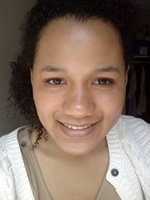
Why NanoJapan?
This program helps cut down the barrier between the sciences and the humanities. There has always been this misconception that lab work and science, especially in America, means giving up on study abroad and language study.
I come from a well-rounded scientific family, and was raised on mathematics and engineering and practicality, and yet the humanities have also always been important to my family. Foreign languages were important. Reading and writing were important. History was important. My family doesn’t believe in the mutual exclusiveness that has dominated the field, the belief that English and a working, practical brain is all you need in the sciences; and neither do I.
I am looking forward to continuing my well-rounded path in this program, in adding another notch on my research tree, in adding technical Japanese vocabulary to my language arsenal. I am looking forward to making myself a more global citizen.
My goals for this summer are to:
Japan is not as surprising as I expected. It’s a good feeling though, that I don’t really feel out of place. I can hold full conversations even if my kanji level is horrendously poor, and the people here are just as nice as I had hoped.
The no-touching “rule” for the opposite sex is pretty much what I imagined though. It’s just a funny feeling looking on as the guys get to give each other man-hugs - even if some of them are the most awkward (and cutest) things I have ever seen. Also, some of the Japanese guys just won’t talk to me. I’m not particularly offended, because the majority will if I speak first, but it will take time to get used to the fact that completely ignoring someone next you is not particularly rude… unless it really is, and because I don’t know, they can get away with it. I am 100% sure this is not a Japanese thing though, and the sheer variety of personality and personal style I see here makes me realize that strong group identity and strong individual identity are not as mutually exclusive as people make it out to be.
Another note on human interaction: I haven’t bowed this often since I was a kid being towed to family occasions, temples, or anywhere else my grandma wanted to go. It’s comforting in a nostalgic way that this way of showing respect is still well and alive.
The most entertaining thing about Japan is that a lot of people seem to think that Americans know nothing about Japan. One of the KIP (Japanese) students was surprised that I had eaten tempura, sushi, and pretty much all the “popular” Japanese foods except for natto. People are surprised for a few seconds that I speak Japanese, and I’m beginning to work out a balance of English and Japanese in conversations with my Japanese friends so that they can practice their English and I can practice my Japanese.
On a specifically food-related note, because I am a foodie at heart, food (though not groceries) is ridiculously cheap. Between the konbini, school cafeterias (at the school of one of Japanese students, they sell curry rice for 280 yen!), and even just family restaurants and such, I am always impressed by how cheap food is, even in more touristy areas. Moving onto a more tourism-related note, I ended up visiting Keio University, the University of Tokyo, Kamakura, and of course some of the major tourist points in Tokyo, like Shibuya, Shinjuku, and Harajuku. I will never likely never see such a larger moving mass of people than the ones that appeared in Shibuya and Shinjuku. Maybe if I visit India.
In contrast, Kamakura was extremely peaceful around the temples. I felt really calm and together, and I began to wonder what my life would have been life had my home been a temple. All the green of the scenery itself made me so content, and I realized that I probably wouldn’t be able to live for a long period of time in a city, without living part-time in a park or something. Maybe the Buzzfeed quizzes are on to something, because the green was just so powerful to me. (According to Buzzfeed, my spirit color is green.) I also ended up getting an omikuji, though I was terrified of it at first. Toshi-san got one with me that made me feel better about the event, even though the end result for both of us wasn’t bad.
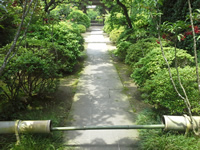
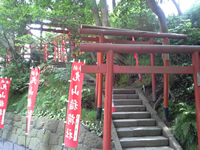
Language Classes
I am the only one in the advanced class. It’s just me and Shimojo-sensei for 3 and a half hours, and occasionally I wonder if he’s bored with me. I’m fairly sure that he thinks I’m particularly strange, and we learn a lot from each other. Also, according to one of the KIP students I have a Kansai accent. According to Shimojo-sensei, I do not. It is flattering to keep hearing from the KIP students that my Japanese sounds like that of a Japanese person though.
We only have the special Friday classes (with the AJALT instructors) twice this year because of the Kyushu trip, but my first Friday trip was great. It was actually my first time in Ikebukuro, and Takami-sensei and I went to a disaster prevention center. The trip basically involved one of the best lessons I ever received on how to act in the event of a earthquake or fire, both of which are also fairly common in southern California. We got the chance to use the fire extinguishers, use the earthquake simulator (yes, they do exist, and they are somewhat terrifying), and watch a really interesting short movie documentary about the 2011 disaster. I use the word interesting because it was moving in a way that I don’t think I’ve ever experienced. I might feel closer to the event now because I have seriously considered living long-term in Japan later in my life. Earthquakes, if they’re small (less than around 5 on the Richter scale), don’t bother me at all, but I’ve never experienced a large one, and even by living abroad here the next spring semester, I am subjecting myself to the high possibility of a major Tokyo earthquake. However, regardless of the frequency of disasters, I wish that southern California had better education on how to behave in the event of a disaster, beyond stop, drop, and roll and the such. We have earthquake drills all the time, but that simulation (ours was specifically of the 2011 one), taught me more than over ten years of earthquake drills.
Intro to Nanoscience Lectures
Kono-sensei’s science lecture at Sanuki was intense in a way I wasn’t expecting, though this may have to do with the fact that it was the afternoon, and as a morning person, I am barely functional in the afternoon, especially after lunch. His lecture at Rice was much more an overview than anything, with some basic equation pumping. He introduced the subjects with classical physics, specifically the classical theory of electrical conductivity. He then used the classical equations based on Drude’s model to introduce the idea that because the equation used to calculate the conductivity of a material is based upon both the density term and the mobility term, high conductivity can come from either or both terms.
I particularly liked the way he brought up the difference between a metals and semimetals and insulators, with the latter two treated as one group. I had never really thought fully about the implication of a metal, and why its resistance would increase with temperature while the resistance of the second group of materials decreases with temperature.
I wish he had gone a little bit more into application of the Hall Effect, mostly because it was mentioned by a professor at the one of the labs that we had visited at Todai, and my understanding of the concept of the Hall voltage didn’t contribute to an understanding of its application.
The guest lectures from the Japanese professors this week were fairly varied. I found Dr. Fon’s story really interesting, as well as his research in the near-field with free-electron lasers, which then related back to another lab we had visited at Todai (the one with the only and first woman in the Applied Physics department). The other lecture from a Japanese professor was on Japanese humor, which is apparently highly contextual. I hadn’t thought much about the type of humor I had encountered in Japanese culture, but I guess it is. My family uses the same type of humor, severely lacking in any of the stereotypical knock-knock or hypothetical jokes, so I hadn’t really noticed the difference.
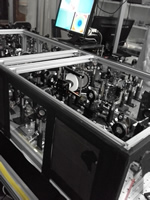
Regarding lab visits, they were very concentrated. I will include Elionix in this section though it is not a lab, because I found the 3D SEM ridiculously interesting, although I did wonder why no one had thought to come up with one before, if it is supposed to be that promising. The Todai labs all differed in the ways they explained their research, largely an effect of their English ability. I found the optics labs, and the specific arrangement of glass and mirror to create the desired wavelength of light intensely complicated. One of the labs (Iwasa-sensei’s) had an interesting overview of the intersection between chemistry and physics, and they had focused in on using organic reagents in conjunction with nano devices with the desire to achieve semi-conductor in which induced voltage could directly affect the conductivity of the device. This was the lab that appealed to me the most, probably because I am technically training to be a chemist and the way he introduced the frontier of devices was really interesting. The lab work that made the most the sense to me was probably the group that specialized in CVD production of graphene, though this is probably because the models made it easy to see how the sheets folded up into single-walled or multi-walled nanotubes.
Research Project Overview at the Aoki/Ochiai Lab, Prof. Noboyuki Aoki & Yuichi Ochiai, Chiba University The material that I have been assigned to is graphene, specifically in conjunction with h-BN (boron nitride) in device fabrication. Graphene is a semi-conducting material, usually with some sort of added fabrication or manipulation method to help easier attach the 2D (atomic) material to 3D metal electrodes. Graphene is special due to many of its properties, from its electron mobility (higher than conventional semi-conducting materials like silicon) to its current capacity, which is fairly high and contributes to its presence in electronic device research and development. Regarding its semi-conducting properties, the band gap of graphene can also be tuned to 0, a very different pattern from the usual semi-conducting material. I will be making a graphene sample on hexagonal boron nitride (h-BN). The structure is expected to have high mobility and show ballistic transport at low temperatures, and my task is to confirm these transport properties.
Regarding the public transportation in Tokyo, there really is not much of a difference between the interactions that occur on a subway or train in Tokyo or one in Boston. I take the T in Boston back and forth to my library, my part-time job, and wherever I feel like going to break the Harvard bubble, so I would say I’m fairly versed in public transit. I suspect the lack of difference may have to do with the fact that not that many people ride the T (the local subway) in Boston, and I avoid rush hour like the plague, but there really is not much of a difference, besides that the subways here make no horrendous screeching sound when they stop and the obvious increase in frequency, speed, cleanliness, and overall convenience. People are generally quiet, with the occasional obnoxious loud group, who here, may or may not be made of foreigners.
I was actually somewhat disappointed to find that the trains and subways were not as deathly silent as I had heard they would be. If the subways and trains were any louder, I would be wearing my headphones basically 24/7. The only rule I would say is slightly different is that if there’s an open seat, you take it instead of standing up during light (or more light) times. That and that people sleep often. I have yet to figure out how they wake up in time when by themselves (I sleep when I’m in a group), but they do. I guess if this were to be coded into a rule that people follow (excluding young rebels and insensitive foreigners): either a) do something on their cellphone (or DS or PSP, etc.) b) sleep or c) talk quietly amongst them selves. I haven’t faced any problems with the rules, and I am constantly annoyed when people break this harmony.
Oh yes, and people do not eat on the subway. Not that they ate often on the subway in Boston, but this is an extension of the general no-eating in public “rule” that is in place here. I have thus far seen one man (late at night) eating something on the subway, and I stared (discretely, of course) for more than a few minutes. Other than when I’m particularly starving, I’m not really annoyed by the rule. It prevents awkward encounters involving food and drink on people’s clothes in a non-festival, or other loose food setting, so I find it practical, especially when clothes are so expensive here. That and the smell of food is very strong in contained places, though my sensitivity to smell doesn’t usually lead to a headache if it’s from a natural source (as opposed to cologne or something).
Regarding politeness in general, I wouldn’t know if there was any particular difference. I mean, I bow a lot, but this has more to do with my upbringing than anything. Other students have mentioned that the motion is becoming automatic though, so I would say that we are being converted to more respectful people in some way. More so, I find myself recalling all the scoldings I received on posture, eating etiquette, etc. as a kid. I thank people for every little thing, but that’s not particularly something that I picked up in Japan, as much what I used to think was a personality quirk.
On a completely unrelated note, most people aren’t really surprised that I speak Japanese either, only that my accent isn’t particularly gaijin-like. I suspect this is because I am a woman. Men are less expected to pick up the language of the area than women, the same way statistically, if a foreign man marries a Japanese woman, he is less likely to be or become fluent in Japanese, than a foreign woman is if she were to marry a Japanese man. I don’t know whether this is an Asian thing or not, but my brother is definitely less expected to pick up Vietnamese than I am, the same as how my younger male cousin than his older sister (she’s already fluent.) It is definitely a double-standard, but I just don’t know whether it has to do with the culture, or the idea that men are worse at learning languages, or that they just put in less effort.
I admit fully to sharing this bias myself, in that I unconsciously expect myself to be disappointed every time I ask a foreign man with a Japanese wife whether he speaks Japanese. This trend is depressing, no?
Note of distinction: Culturally, I find Japan more similar to my hometown area in southern California, though regarding public transit, I find it similar to the Boston area, where I go to school.
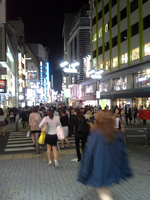
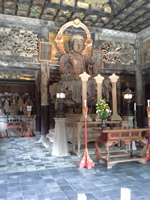
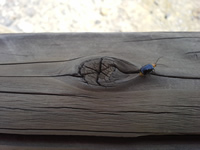
Intro to Nanoscience Lectures
Professor Bird’s first lecture was basically a crash course in quantum chemistry and physics (he calls it review of solid state physics) with an introduction to band gap engineering and a smidgen of application of semiconductors and how they work. Being such an easy-to-understand crash course, everything was useful, if even as review.
He began by asking why quantum laws were important, and then used that terminology (that the possible energies are quantized) to explain the existence of the “forbidden gap”and hence the existence of the valence and conduction band, continuing into the point of using heterostructures and the effect that this manipulation has on the band gap.
His second lecture focused more on graphene specifically as a semiconductor with mention of specific growth methods and applications, and the only thing that really stuck out to me that was that because of the nonexistence of the band gap, making a transistor out of graphene is almost impossible in real-life application because there is no way to turn it off. The absence of a gap also allows Klein tunneling of electrons by conversion to holes, increasing the number of tunneling electrons as the barrier increases (opposite to how tunneling normally works). It made me think of my project, in that the lab is trying to replicate the result of another lab that supposedly was using graphene ribbons (1D) on the edges in devices to combat the natural weakness (and strength) of graphene and induce a band gap.
The only other lecturer this week was Ishizaka-sensei, the first female professor in the Applied Physics department at Todai. She discussed both her research and her path to becoming a female researcher in what has historically been, and still is, in every country, a male dominated field. Her research dealt primarily with a specific kind of spectroscopy, called angular resolved photoemission spectroscopy, that she could use to determine the spin and orbital properties of bodies of electrons. Even at this point as a math and science oriented college student, it’s crazy to think how much we can find out about a material by bouncing different frequencies at light at different angles.
As far as her stance on being a woman in science is concerned, it really resonated with me, despite the fact that our ability spreads are completely different. She mentioned that even as a child, she didn’t consider herself any good at the humanities, and when she eventually learned physics in school, she fell in love with it. She became a professor after a lot of nudging (from her friends and family to apply). I feel like she exemplifies the exception that a lot of women’s STEM movements overlook as an important part of the perception of woman in science. It should be natural to be a woman in science, and honestly I don’t even know what the average sex ratios in STEM would like even if woman were encouraged to go into STEM as much as men.
On a related note, I like the fact that she didn’t seem at all uncomfortable about being a woman in the workplace, as much as I really don’t care that the gender makeup of every science class in college has been skewed toward men. I can’t say I even notice it, unless someone points it out. The entire situation reminded me a lot of a somewhat uncomfortable experience I had at my father’s workplace in which I was asked how I felt as a black woman looking to go into science. I didn’t know then what I was supposed to say, and I don’t know now. I just feel like myself.
Am I supposed to be uncomfortable and want a lot of female friends to go into science with me? All I can ask is that every person (not just woman) consider every field of interest fully, and have the resources and openness to choose whatever they really want to do. This wish is what needs to be fulfilled in my eyes.
Miyazaki-ken was just a lot more normal than I thought. Based on all the lectures I received on the dominance of the patriarchy in more traditional Japanese families, I was expecting a note of male-dominance in my host family. Rather, in stark contrast, my host father directly mentioned that the women ruled their house, from the grandmother to the mother. When I mentioned this to Shimojo-sensei, he said that he believed that the home was more stable when women ran it, which is kind of ironic considering the negative stereotype of woman being irrational, emotional creatures. The dynamic might have different in this family though, even just because the man had three daughters. You can ruin yourself with bitterness if you insist on being sexist with three daughters (and no sons), considering that they are the only ones that can continue the family legacy, regardless of whatever their last name may become…. or so I believe.
On an equally important note, the food that my host family served was amazing. There is really no other way to describe it. The sheer amount combined with the sheer deliciousness of it all had Nicole and I looking at each as if we had hit the jackpot with home stay families. (The mother ran a restaurant (and coached volleyball!) while the father led the Kyushu chapter of taiko and did a bunch of other things). Basically they were amazing. The kids were adorable, even if they didn’t talk to me that much, and I listened to more One Direction there than I have in my entire life. They are apparently very popular here, even among high school aged boys. (Or so one of the high school kids at Gokase I talked to made it seem).
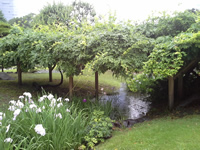
As far as my greatest amazement, it was definitely the sheer amount of green. I was moved in a way not dissimilar to my moment at Kamakura. There was just so much nature, and all the emotions I was introduced to there really resonated with me. I haven’t been able to see the stars in ages.
I felt sad with the local people when they sadly mentioned that all the young people were moving away, putting even more of a strain on the people that remained to support the older generation. My host grandfather (who was so sweet as was my host grandmother) told Nicole, me, and Anni to come to Japan and have kids to boost their birthrate. Even though I laughed, I was definitely touched, if in an odd way. I guess if I were to end up marrying a Japanese man, I would stay in Japan, or maybe switch my time around a bunch of different countries.
Even though I feel like the countryside was supposed to be a big shock to me, I just didn’t find it shocking—-I found it comforting. I wouldn’t necessarily mind living there, but what I want to do just doesn’t lend itself to living in what is essentially the Japanese equivalent of the middle of nowhere. Maybe in retirement?
So I guess my major response to Kyushu was that it was not life-changing, but it was definitely life-fulfilling, if that makes sense. I felt so full (spiritually and physically) there, and while I wouldn’t call the feeling “happiness,” it stirred something that I don’t think I can describe in proper words, bubbling over in a desire to return, and not just because I happen to come from places where nature is limited and controlled and the seeing the stars is a far dream.
We also visited an active volcano. I didn’t think I would ever get as close as I did to one, to the point that the sulfur made me go into coughing fits. Nicole and I both found it interesting that the sign warning people with asthma, heart problems, and other breathing troubles shouldn’t go to the crater, was in the crater….. Maybe we just went in the wrong way?
Regarding Gokase, it ended up being a lot of fun, despite how badly we had panicked before hand, from making the experiment work to explaining the right hand rule in Japanese. To whomever it may concern, the Japanese don’t learn the right hand rule. They use a left hand rule. Which makes no sense to me. But to be perfectly fair, neither the right hand rule nor left hand rule ever made any real sense to me.
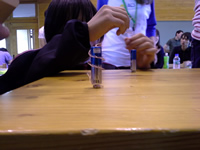
The kids were brilliant. I mean, I knew that coming in, but they were really great engineers. Skyler and I decided that they had definitely beaten YouTube even with regards to efficiency; the designs that some of them had come up with were that amazing. (pictures attached) We were especially impressed with the spring design, which we knew logistically worked, but hadn’t had a chance to practically do it. The other design pictured had incredible stability, spinning incessantly for half an hour or so, even after being moved.
Following the trend I’ve noticed regarding comfort with the sexes, the girls were more willing to talk to me than the guys, who, if as soon as they responded to a question immediately clammed up. I know logically it hasn’t been that long since I was in high school, but the Gokase kids were adorable in a way that definitely sparked some sort of older sisterly instinct.
Overall, Kyushu scraped up part of myself that I feel like gets buried when you live in a city too long, work too many long days, don’t spend nearly enough time thinking in the midst of all the doing.
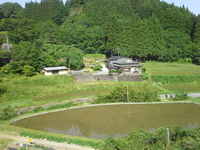
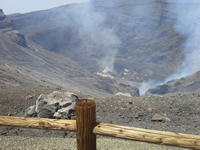
Overview of Orientation Program & Language Classes
My most helpful experience was probably either language classes or Kyushu, more specifically the home stay and the time we had spent with the Gokase students. The least helpful experience… going to five… or was it six… lab visits in a row when we visited Todai. I normally am fairly excited about lab visits, but going to so many labs in a row was tiring, and made each individual lab into a flash of equipment almost indistinguishable from the next. Or maybe I just have an incredibly small attention span.
Shimojo-sensei is awesome. Though I guess I don’t know how I would have survived 3.5 hours of classes with someone who was anything less than…. I have run out of adjectives. We basically did a lot of technical Japanese, and I found out that for every English word for the elements, there is a Japanese one. I’m still not sure how I feel about that…
Strategies for learning Japanese:
Be a good listener in conversation
You can pick up specific phrasing that real life college students use
Best way to figure out how to adjust your “accent.”
Review daily. Languages are cumulative.
Ask questions. Constantly. Even better if you can infuse some humor into them to make you and your sensei less bored.
I spent two fridays with Takami-sensei (an AJALT language instructor) as well, and along with the emergency prevention place (mentioned in a previous report), this week we went to a government building, the place with in which the Japanese Diet meets. During those trips… we just hang out I suppose. We speak only in Japanese, and I try to understand all the lectures I am given by tour guides and such. It’s definitely a fun reprieve from being inside a classroom (mostly) all morning.
Research Update
Professor Stanton did a rehash of previous lectures with additional material on femtosecond spectroscopy, spaghetti splots, and terahertz waves—creation and application. I found the specific bits about how terahertz waves can theoretically be used, and how to get a terahertz wave from a semiconductor surface and a femtosecond laser. Apparently, the lab that he referenced used it to differentiate between English Breakfast tea and Earl Grey tea. While it seems obvious to me that the latter reeks of bergamot (in a good way; I love bergamot), my tea senses tingled at the slide. I think other things that he mentioned regarding specific phenomenon, such as negative differential resistance or conductivity, could have been more useful had I remembered more of my physics theory.
The guest lecturer this week was Otsuji-sensei. He focused on his own research, which was regarding the existence of plasmons and photons in solar cells to raise efficiency of graphene above the admittedly high 2.3% percent of white light (for something only an atom thick) based purely upon a constant that is adjustable. It was interesting, mostly because it seemed more applicable to real life, because solar cells are a very real way to reserve natural resources using something we almost always have in unlimited supply.
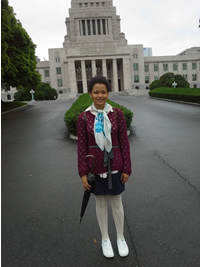
My first day in the lab at Chiba University was interesting. I found out that my lab likes to begin work at 10… or later. Fairly dependent on the later. I am a morning person (wake up at 6 daily), so I found the gap between waking up and going to work a little troublesome at first, but I have since gotten used to it.
Also, basically no one in my lab speaks English, except Aoki-sensei. Which I don’t necessarily mind, but it was a change of pace to end up translating my grad school student’s lab orientation lecture thing to Chris, with bits of Google Translate thrown in. They love Google Translate here. I just hope they’re well aware of the randomness that it spits out it’s not a specific word you’re looking to translate….
My mentor in the lab is Takeda-san, a first year Master Student. He is not a morning person. I have the suspicion that he thinks I’m nuts, but we have fun trying to fill in our language understanding gaps (because no language class ever teaches you what vapor deposition translates to in Japanese). Other than that, I would say that he is about the epitome of chill, has trouble remaining awake before noon and sometimes after depending on how much class he’s had, and is a mahjong fanatic. I had never heard of 朝まで麻雀(あさまでマージャン)、or “until morning” mahjong until I met him. In other words, he can play all night long. He was really excited when he found out that I played mahjong (which I do, very, very badly).
Although this sentence will sound insanely obligatory after that paragraph, he is very clever, to the point where his seniors rely on his input and intuition on how to figure out some of the problems with samples and such, and he’s very fun to work with. He never hesitates to explain anything that I ask him about to the best of his ability, something which I greatly appreciate.
Aoki-sensei is technically my head supervisor. He does speak to me in English, but slips into Japanese quite a lot. He has really kind eyes, which might be a strange thing to notice, but I get the sense that he looks after each and every one of us. Plus our secretary, Tsutsui-san is only here 2 days a week, so he automatically becomes our go-to person depending on the problem.
Matsunaga-san is Chris’s mentor, but we end up interacting a lot a) because he lives very, very close, and b) he is a PhD student (first-year) that the other master students rely on a lot. He wears what is the equivalent of a track suit every day; I have thus far marked I think 4 colors. He has an interesting sense of humor and like the rest of the lab, sees to it that nicknames are properly used.
Akaram-san (I apologize in for the misspelling in advance, but this is my attempt to translate his katakana name in romanized letters) is the only other person besides Aoki-sensei who speaks fairly fluent English. He is ethnically Sudanese, but has never lived there, and is another go-to person for all of our technical sample problems. He is a third year P.hD student. I often rely on him for the foreign perspective as well as language tips. He is very fluent in Japanese.
I’m going to interrupt my “character” list for a second to clarify a difference that I immediately noticed when I came to the lab. In Japan, they much more clearly differentiate between master and doctorate students. Masters almost always takes 2 years here, and most people go job-hunting afterward instead of working toward their P.hD (also standard in America). However, if once you finish your masters you decide that you want to be a doctor, you then begin the first year of your doctorate. In the U.S., in a lot of schools, you would because considered a third-year P.hD student (the third year in your ideal 5.5 years to your doctorate), because if your goal isn’t the masters, they just count it as a time mark. In Japan, they consider the doctorate path 3 years long, though it has the prerequisite of an additional two in masters.
Mineharu-san is my direct senpai-like figure that often takes over when Takeda-san has class (which is fairly often because first years Master students still have class but fourth year science undergrads have none—-it’s all lab work). He shares my (not-so-great) mahjong ability. He’s very good at karaoke and likes purple pants (though he insists that they are very popular, I have yet to see another guy his age wearing them). I rely on him a lot for providing explanations for what other people in the lab do, and I think we’re adjusting well to our language dynamic.
Akina-san is the only other female in the lab, who will actually be absent for the next two weeks to visit her family. I would consider her probably hands down one of the most studious and reliable people in the lab, but she has a great sense of humor and we get along very well.
Those are basically all the people I communicate with on a very regular basis (besides Chris, of course).
Quick shift to housing. It is cheap and what all the other Japanese people consider old. I don’t really mind. The only real inconvenience is not having a microwave. Or a rice cooker. Which means I can’t prepare food in advance and store it in my fridge. But I’ve learned to work around it, and I don’t have a problem with the space. My dorm at school was smaller and didn’t have a bathroom or mini-kitchen, so I will consider this an upgrade. I commute to my lab by train, though I have been trying to walk at once. (Though in this heat, probably not happening anytime soon). I did have to buy and borrow cooking tools though. Though they sell fairly good quality non-stick pans for basically 500 yen. Which is amazing. And groceries are cheap, except for meat.
Another shift to research project. The aims of my project are clear however my mentor hasn’t learned the entire process from his senior, so the entire thing is a bit unclear right now. For now, I’m just reading papers in an effort to be more informed.
An overview on language: I speak basically 98% Japanese here, which was what I wanted when I applied to the program. At first I was worried that I just wouldn’t get some things, but I feel like the obvious necessity for me and my mentor and senpai to google translate and flesh out words that I don’t know has improved my understanding of the process more than an entire explanation in English would (because English has a tendency to glaze me). But it is certainly is trouble that because I generally take in the gist of things and don’t translate every term, I may be missing certain things. I don’t I’m missing anything extremely important however, because they always emphasize the important parts for me. I am getting to the point where I don’t remember what I say in English or Japanese though.
List of things I want to do in Chiba: Actually, it’s not a list. The only thing I’ve set up is a trip to Tokyo Disneyland. Hopefully when it’s raining and nobody wants to go.
Research Update
Research Project Overview: Our goal to use a a process learned from a Korean lab to fabricate a hexagonal boron nitride graphene structure with ballistic mobility properties in line with what has been published. We are looking to specifically improve the sample mobility to fifty times of what the lab has achieved in the past.
Research Methods: Papers, specifically the paper that details the process and why BN works so well. A lot of fabrication is skill with dealing with small things with tweezers though. That and intuition for little tweaks to the process that could improve mobility. The little tweaks… according to Akaram-san are a mix of talent/intuition and knowledge of the process.
Training: I’ve been doing of lot of what they call 見学, which is learning by seeing. So a lot Raman-scattering. I’ve begun training on creating samples, and which that has come instructions for microscope usage.
Questions or Issues: I don’t know how accurate our timeline actually is. That’s about it.
Timeline: Until the middle of July we will work on creating BN samples with high mobility, and then after that focus on low-temperature testing (I think the helium cooler gets it around .3 K, though I could be off by a magnitude of 10). As we haven’t completed a successful sample, posters have not come into the picture.
Pictures
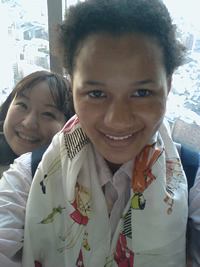
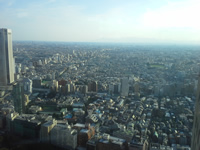
The Tokyo Metropolitan Building with Anni. They let you take the elevator up to the 45th floor (it only takes 55 seconds), and you can see almost all of Tokyo.
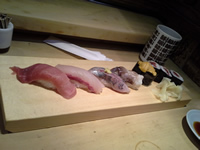
Food one: (I can’t remember whether this was submitted in last week’s) Last Sunday in Tokyo, I went to Tsukiji with two of my KIP friends. Hands down best sushi in my life. Sushi is great at any time of day, even at 7 am in the morning.
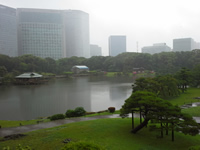
Other scenery: O-Daiba. A giant man-made island kind of reminiscent of Dejima, but not really. It is humongous. And expensive. The center is very close to the Hama-rikyu gardens, where a lot of the green and trees are from. It is also home to 日本科学未来館(にっぽんかがくみらいかん), or.. I have very little idea what this translates to anymore than literally Japan’s Science Museum of the Future. But that makes no sense. It is huge (with floors and floors of exhibits and even a workshop), so I’ll probably make my way back there when I go back to Tokyo.
The only thing that I can possibly think of is that basically no one lets me pay here. For food in particular. And it is kind of frustrating because I don’t feel like I can ask any of my friends or coworkers to go even eat something with me because they insist on paying and then it feels like I’m asking them go buy something for me. Which considering that some of them are students on a budget, that’s just ridiculous. I’m learning to be sneaky.
On a completely, unrelated note, I have gone back to Tokyo three or four times in the last two weeks. So I got a chance to visit the imperial palace park, the area of which is apparently the tourist destination in Tokyo. The funniest thing is always when foreigners turn around or just spend a couple extra seconds to look at me when I’m speaking Japanese with my friends.
On a related note, I found out that a phrase that I use often apparently made my lab wary in the beginning, because it sounded as if I were pissed. Since the phrase can be quite neutral depending on the tone, I found this kind of interesting, but it’s a difficult personal habit to kick, even though my friends and coworkers insist I don’t have to.
And I went to go play mahjong. (Not solitaire mahjong, which apparently a lot of people are deluded into thinking that that is real mahjong). Riichi, or Japanese mahjong of course. (There’s also a Hong Kong and mainland version, if I remember correctly). Which, if you ever decide to learn all the rules and regulations and play that deal with mahjong, is a very, very fun thing to do with an automatic mahjong table. I literally spent 5 hours in the same position playing this. If you like mahjong, it’s a much cheaper version of entertainment than a maid cafe (also in Akihabara).
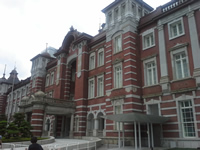
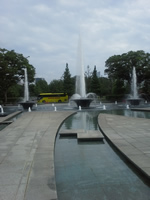
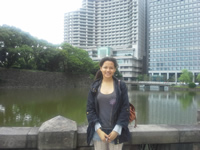
Research Update
I have just started an active role in making the boron nitride samples. There are have been no revisions to my project. At the moment, no particular research difficulties, though I am talking through with another one of the grad students about how to improve the method (get monolayer graphene on a fairly big area).
There are no rules. I mean this in all honesty. I asked my lab members, and they said the only rules are no violence, and don`t get angry, though the latter can be ignored by the professor.
There are cultural customs, as in any country, such as taking off your shoes and wearing slippers. There are safety and research guidelines and restrictions, such as wearing only specific shoes in the clean room and wearing gloves to handle chemicals. But this is really just common sense. We can’t afford for our samples to be contaminated with dirt, dust, etc. We don’t really use keigo in the lab either. I use the suffix –san to refer to everyone that doesn’t have a nickname that they asked me to use, but that’s about it. I don’ t even use –desu/-masu form with the undergrads (who are grade-wise, my senpais), but of course this is also dependent on situation. Asking for help is significantly different than asking what they did over the weekend.
My lab in the U.S. was very lax and small when I worked in it, so the hierarchy was not as strong, but I really don’t think seniority (in my lab) is as important as how knowledgeable or skilled a person is, contrary to how we were introduced to the topic. Undergrads in general (especially in Japan) are less trained in theory and have less experience in the lab, and therefore they rely on their senior members. It’s a very natural cycle, though it of course can be broken, just like how as a high school student I taught PhD students about some of our sample making methods and how my direct senpai, Mineharu-san, taught a master tudent intern that came into the lab.
Mineharu-san has a host of other talents in sample-making that make him a very reliable person in our sample process. I like this research environment probably more than I liked my lab in the U.S., but this is probably because of the more family-like aspect of the lab. Aoki-sensei and Ochiai-sensei take care of us, just as our senpai’s do, just as my own family would. The bonds feel a lot stronger here between members of the lab than in the U.S. (generally speaking). It’s a very good balance between work and personal life that is goes on here, and it does create an environment where everyone can really empathize and form strong friendships. Though I do get the impression that not all labs have this dynamic from my friends in the lab.
I actually just went out with my lab to play darts after dinner, which was a blast, actually. After failing badly the first round (really sorry about that Akina-san), I went on to be at least decent. This is the last week before Okinawa, and I definitely feel like I’m going to miss my lab a lot. The pictures attached are quite boring because I didn’t go anywhere this week sight-seeing-wise, and the rain, well, rainy season is like none other. It is like sheets of hail (but rain) in terms of intensity. Every time it actually rains here (as opposed to drizzling), the rain carries more water pressure than the shower at my dorm. And no, I didn’t just watch the rain thud down. I ran through it like a crazy person with no rain jacket and no umbrella. It was amazing, and basically impossible to breathe. Anaerobic exercise like no other.
Note: Before you think I am a crazy person, I had actually forgotten my jacket (which I almost always bring), and then just decided it was fate. And I didn’t want to be really late to work, so I just pushed through. I was soaked to the bone and dripping to the point where I had to go into the bathroom and squeeze excess water out of my clothes.
I guess life here has just become really, really normal. And I like it this way. Still learning a lot of new things (we’re on the idiom chapter in Japanese class), but it’s really comfortable, and I feel like an actual student here.
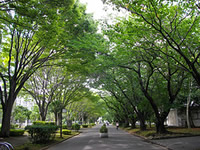

Snapshots of a typical day at Chiba University
Research Project Update
Vapor deposition failed because gold mixed with the titanium (and then resistance was too high). That’s really only the setback I can think of, because we had to remake a lot of samples. We also broke a vacuum pump (or a vacuum pump broke down on us, depending on how you look at it), but that’s pretty much all.
I’m about 80% done learning the process in making samples, and one batch of samples takes several days to complete that 80%, so there is still a lot to learn, though I’ve learned enough to be helpful. The good news is because we do basically the same things over and over again, the repetition of certain words has improved my technical Japanese vocabulary.
Some of the samples are also not as clean as we would like, and some of the graphene is not as thin as we would like, but we really won’t know a lot about the quality of our samples until we start the low temperature testing. I’m still thinking through different methods of mechanical exfoliation for our next batch of samples, because one of the best bits of single layer graphene had been ruined by a cross over with the tape.
Apparently, my presentation was helpful in some way though… we have decided to cut out the HDMS step in the post-Boron transfer process. My lab had always used HDMS for the photolithography to improve contact, but because it is very difficult to remove all of it, the layer could ruin the contact with the metal bit of the semi-conductor. So I am really curious to see what effect removing the HDMS from the progress will do (because apparently they have always done it this way). I think we may experiment with the revolution speeds and timing with the spin coater though.
On that note, there aren’t really particularly arguments that happen in the lab. If you have a good idea, or just an idea, you typically bounce it off your senpais, who then think about it either offer an answer or ask their senpais. Often this chain of knowledge leads straight to the professor who will give either give the green or red light. Though I will say that this red light is final. Especially if you have no solid evidence around your idea. But students, if they put in the effort and research, then their opinions are much respected here.
Biggest personal accomplishment: I found the courage to try to enter a circle (club) at Chiba in effort to make friends outside of the lab. Currently in the middle of the entry process, but the people I’ve met thus far are really nice.
Biggest personal challenge: Reading enough (but not too much) into what people say and expressing my feelings exactly. There are definitely things that they expect me to realize, and I would say 99% percent of the time I do, but that one percent is so nerve-wrecking, because then I think for a ridiculous amount of time on the topic. In the end, I’ve just ended up asking and getting an answer (and relief) out of it, but it’s still a challenge once in a blue moon.
Progression with research: Slow. In a mediated… panic(?) mode at the moment. I’ve been told it’ll be okay, but even my master student is freaking out a bit.
Mid-Program Meeting in Okinawa
It was really fun seeing everyone again, but I couldn’t help but miss my lab. Okinawa was hot. Southern California can be hot (especially in the Valley), but it isn’t humid. The air was thick enough to choke on, not from smog, but from moisture. As a result, Okinawa was almost painful in some ways. (I don’t deal with temperature difference well. So I am grateful for the Japanese tendency to use weaker air conditioning.) I did buy my first souvenir there though. The shisa were too adorable to go without.
Also, our group ended up, while out for food and drinks, dancing with a bunch of people who appeared to be native Okinawan women. Once we got over the strange suddenness, our entire group got roped into it. It was almost exhilarating (dancing in front of everyone, if you can call what I do dancing), though I did quite a bit of the no-inhibition thing over the weekend. For one, going jet skiing with one of my friends fifteen minutes before she had to leave for the airport for her flight back to Tokyo (and to drop off her car rental).
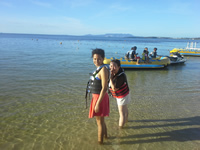

Jet Skiing with my friend in Okinawa
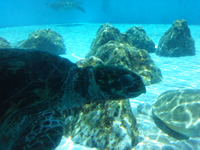
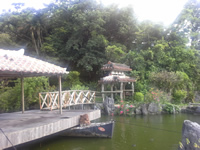
Pics from our trip to the Churaumi Aquarium and the Ryukyu Mura Village
Research Project Update
I have just been making samples. We’ve made some updates to the sample process to improve contact with the metal (prioritizing that over contact with the photo resist) and limit the amount of dirt on the sample, but that’s about it.
We haven’t met any particular difficulties, just adjusting to what Aoki-sensei tells us. I’ve been thinking about the different adjustments to the processes that we do and the fact that a lot of the former problems I have actually considered either out of curiosity or on the behest of the head of the graphene group has made me want to be a little forward with my opinions on the procedure. I think I still want to read up on some other things a little bit more though. We have not started taking any particular data from the samples.
Japanese language acquisition to date: I don’t really notice anything in particular, but according to my Japanese friends in Tokyo (whom I meet fairly often), my Japanese has gotten better. I’ve learned a lot of words, and learned a lot of kanji (reading-wise), so I know I’ve grown in that way. I am taking a Japanese class here. It feels like a lot of time (it adds up to more than 5 hours a week if you count homework and presentations), and I hope that it will bring me a step closer to the N1 in December. The required kanji list for the N1 is headache-inducing though. I could have a full conversation at the end of orientation, and I can have a full conversation now. I can now have kind of a conversation about technical things, but there’s usually a bit of gesturing involved, because I can’t always remember the word for dissolve, etc.
My most challenging linguistic experience…. definitely the science vocabulary. The very first day I understood about 20%, now, I would say I’m closer to 70% or 80%, which is semi-decent. I’m not going to say anything negative in respect of Murphy’s Law, but things are going well.
Also, I mentioned this earlier, but a phrase I had used from the beginning made them think that I was angry a lot of the time, but they have since changed their opinion. So I would definitely, to anyone who isn’t a native speaker, be careful of some of the connotations of the words you use. It’s now become somewhat of a funny personal habit though. There’s a lot of context I understand from hours of drama and conversation with other people (more than enough to be “skilled” according to most Japanese people), but I feel that there’s almost always going to be something I don’t get because I didn’t grow up in this society.
I do definitely get the feeling that I will need to study kanji (and some less used grammar forms) a lot more and be more “booksmart” fluent, which is how a lot of Japanese are with English. My grammar is solid and everything, but my breadth of vocabulary and kanji (beyond the basic) is pretty much based on experience and self-study.
I do feel based on this experience though that working in Japan, or at least in an international context that requires traveling to Japan is a real possibility for me. It’s been very easy for me to adapt to life here, both in Tokyo and the more suburban Chiba, and I would say for the most part, it’s a very happy life. I’ve made friends, gone out with them, been to a lot of different places (from historical to just popular), and had a lot of fun doing fairly normal things. Things I would do with my friends in California or Boston. It’s definitely gotten to the point where I feel more like a long-term resident than a tourist. I will miss the convenience of public transportation though.
If I’m think skilled enough when I go back to the States, I think I’ll try applying for a part-time job at the Japanese market in the Boston/Medford area. (I assume Japanese is a requirement because the recruitment ad is entirely in Japanese with no translation…)
Research Project Update
My part of the graphene group has switched to focusing on making clean samples in preparation to a switch from the 2 or 4 terminal sample to the 6 terminal sample. Making clean samples at this point is a mixture of reducing tape residue from the mechanical exfoliation and other trash around the graphene and removing the PMMA (which is a used a transfer mechanism to move the graphene to the boron) completely, both of which have thus far been a struggle. We have had some success, but when it’s 1 sample in 30 or more, the hunt for what has been done right becomes incredibly difficult.
I’ve started making samples like a mad woman as a result. My group members think I’m losing my mind.
Essentially all the papers amounted [about Haruko Obokata] to the same story, but I would say outside of the issue itself, I am still semi-concerned with the idea of errors in translation, as translating things from English to Japanese in the proper context to can be not just difficult, but impossible in some circumstances, at least not with a ridiculous amount of footnotes.
The story proceeds succinctly as follows.
Important issues affecting the controversy: This issue blew up because she was a woman, and had been idolized as the ideal female scientist.
My reaction? If her quotes were translated correctly, she has a lack of scientific integrity, particularly under stress. The quote from the L.A. Times for her reads, “As long as the conclusions are accurate, I believe it is right to announce them to the world.” Um, no. It is not. At least not according to my sense of academic and professional integrity. It’s unfortunate that none of the facts, or lack there of, surrounding the controversy were particularly beneficial to her reputation, but I don’t forgive dishonesty. Sex is irrelevant to me. If you take yourself seriously as a scientist, take your research seriously. If you take your research seriously, I honestly believe that others will take your research seriously.
When I asked my only female colleague about the case, she said that she believed the woman at first on good faith, but after failing to produce her notebooks or other evidence of her success, was disillusioned. Which goes back to taking your work seriously, which in biology certainly entails labeling and noting everything. It is one of the most qualitative of the hard sciences. I understand pressure. But the amount of mistakes that were supposedly in her Nature submission was preposterous. It’s Nature. Treat it with the respect of at least three proofreads.
On a completely unrelated note… I visited Ramya and the gang in Sendai. I climbed Yamadera, the temple known for having a thousand steps to the top, for the first time, and she, for the second. It was really bizarre being in Sendai, actually. Mostly because I spoke English there more than anywhere else (even more than in Okinawa). But it was also really beautiful (the forest area around the city), and was loads of fun.
Heads up for anyone that misses their shinkansen train: You can either a) try to ride the next immediate train on a unreserved seat b) ask for availabilities for later times, and get on one of those, or c) do what I did and pay the equivalent of 5 bucks to get a reserved seat on the next train. You will need to ask the station attendant about this though, so Japanese might be helpful…

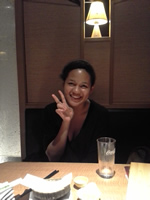
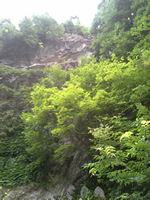
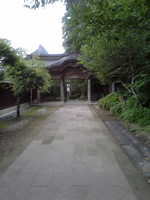
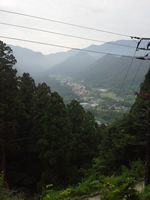
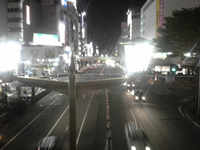
Pics of my trip to Sendai and visit with Ramya
Research Project Update
Things are progressing. We start low-temperature testing of the samples next week. (We already succeeded with the vapor deposition of gold on the six-terminal sample).
Setbacks? Well, having a distinct lack of samples to test. There’s nothing we can do about that this time around, but on the bright side, we did manage clean samples using a newer method of PMMA removal that my senpai and I discovered.
No report submitted
No report submitted
No report submitted